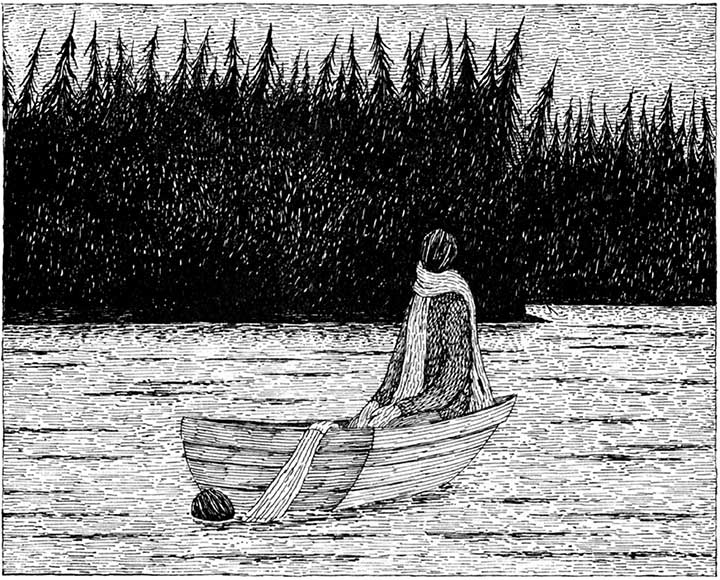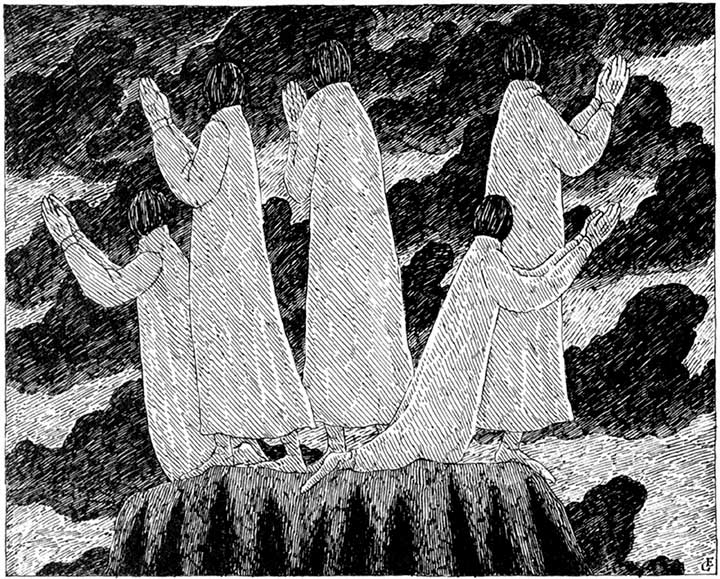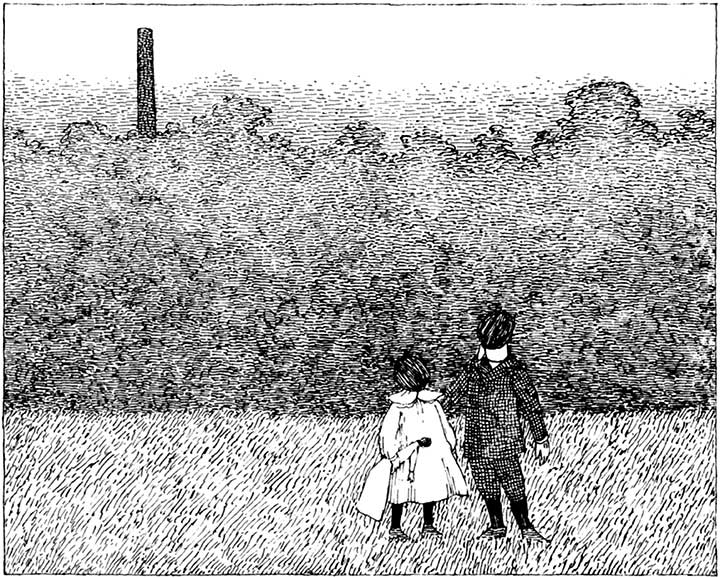One day in 1842, the thirty-eight-year old Nathaniel Hawthorne wrote in his notebook: “To write a dream, which shall resemble the real course of a dream, with all its inconsistency, its eccentricities and aimlessness—with nevertheless a leading idea running through the whole. Up to this old age of the world, no such thing has ever been written.” Indeed. From the first dream of Gilgamesh four thousand years ago on to our time, Hawthorne’s observation proves to be right. Something in the retelling of a dream, however haunting and however true, lacks the peculiar verisimilitude of dreams, their unique vocabulary and texture, their singular identity.
Alice, whose experience of dreams is one of the deepest and most convincing in all literature, is quite ready to admit that words cannot be used to name the endless plurality of the world. When Humpty Dumpty tells her that he uses the word “glory” to mean “there’s a nice knock-down argument for you,” Alice objects that “glory” does not mean “a nice knock-down argument.” “When I use a word,” says Humpty Dumpty in a rather scornful tone, “it means just what I choose it to mean—neither more nor less.” “The question is,” Alice objects, “whether you can make words mean so many different things.” “The question is,” Humpty Dumpty answers, “which is to be master—that’s all!” No doubt, the writer’s task is to embrace Humpty Dumpty’s faith in the powers of language, and be the master, while at the same time convincing Alice that he submits to the rules of a shared understanding, rules over which the words themselves hold dominion. Of course, both Humpty Dumpty and Alice, both writer and reader know, more or less consciously, that this is just a pretense to which we must resign ourselves if literature is to exist at all.
Jorge Luis Borges, the master dreamer, keenly analyzed this paradox in a short text he called “Dreamtigers.” After confessing to a passion for tigers, which he has loved since his childhood, he tells the reader that while he sleeps and dreams, he suddenly realizes that he is dreaming. “This is a dream,” he says to himself, “a pure entertainment of my will, and, since here I have unlimited power, I will bring a tiger into being.” But Borges then concludes:
Oh, my incompetence! My dreams never know how to give birth to the longed-for beast. The tiger appears, oh yes, but withered or feeble, or with impure variations of form, or of an inadmissible size, or all too fleeting, or looking more like a dog or a bird.
In the same way that we cannot deliberately, faithfully construct a dream while asleep, awake we are unable to put into words the complexity of the universe. To avoid or bypass this incompetence, a literary dream, the story of a dream, must be organized differently, made to assume other objectives, appear less keen in reproducing a real dream than in fitting something called “a dream” into the logic and tone of the narrative. Perhaps the only success to which the writer can aspire in dream-telling is to make the reader believe that the characters themselves believe the dream to be a dream. It doesn’t matter if we as readers know (to use three Biblical examples) that the dreams that Joseph tells his brothers are prophetic, or that the dreams that Nebuchadnezzar tells Daniel are allegorical, or that Joseph’s dream about Mary’s pregnancy is explanatory: each of these discussions of dreams works within the narrative that contains it, is justified by it, and illuminates it.
Sometimes the story only pretends to be a dream. We accept, but are not really convinced, that Bunyan’s Pilgrim’s Progress is the story of a dream, or that Dorothy’s adventures in Oz are a dream. This method of framing the narrative in a dream is a sort of excuse for the writer who can then argue that, since this is a dream, everything that takes place in it is possible. However, rather than add verisimilitude to the story, such devices make the reader conscious of how dreams must answer to strict laws of fictional logic. Things may happen that in a realistic story would perhaps be impossible, but even the impossible must follow rules of cause and consequence. After running away from home, Pilgrim can arrive in any country, and after being whisked away by the tornado, Dorothy can land anywhere in the world, but in both cases it must be somewhere, and that somewhere must be mapped for the reader’s guidance. The surrealists, as we know, attempted a few deliberately incoherent dream narratives, but we read them less as examples of real dreams than as displays of verbal dexterity.
Advertisement
Sometimes the story tells a dream only better to question the nature of what we call reality, as in the famous case of Chuang Tzu and the butterfly: “Chuang Tzu dreamed that he was a butterfly and when he woke he didn’t know if he was a man who dreamed he was a butterfly or was a butterfly now dreaming it was a man.” Earlier, Socrates had asked the same question to one of his bewildered disciples: “How can you determine whether at this moment we are sleeping, and all our thoughts are a dream, or whether we are awake, and talking to one another?” Alice faces an even more terrifying conundrum in Tweedledee and Tweedledum’s wood, where the Red King is lying asleep at the foot of a tree and (according to Tweedledee) dreaming of her. “If that there King” says Tweedledum, “was to wake, you’d go out—bang!—just like a candle!” Borges, in a story called “The Circular Ruins,” and Giovanni Papini, in “The Sick Gentleman’s Last Visit,” borrow and explore the same conceit. Segismundo, in Calderón’s Life Is a Dream, does not know how to distinguish between waking life and dream life, though his audience does, and Segismundo must wait for hard reality to teach him the difference. Hamlet’s doubts are the same as Segismundo’s, but expressed in reverse: it is bad dreams that let Hamlet know that he is not bounded in a nut shell, counting himself a king of infinite space.
The apparent confusion between the reality of dreams and the reality of waking life (like the confusion between madness and dreams which Socrates noted in the same dialogue) allows writers to use dreams to question reality without having to attempt an impossible imitation of a dreamlike state. In one of his unpublished notebooks, Coleridge famously wrote:
If a man could pass through Paradise in a dream, and have a flower presented to him as a pledge that his soul had really been there, and if he found that flower in his hand when he awake—Aye! and what then?
So unanswerable is the question, so neatly does it blend the reality of dreams and the reality of waking life, that H. G. Wells, in order to lend verisimilitude to the nightmarish fantasy of The Time Machine, borrowed Coleridge’s unsettling supposition and concluded his story with just such a flower.
In literature, dreams often serve to bring the impossible into the fabric of everyday life, like mist through a crack in the wall. Unfortunately, it often happens that dreams are brought in as an alibi for the unbelievable plot, and the device fails through the writer’s ineptitude. A number of supernatural stories conclude with this cop-out: “It was all a dream!” In the best cases, the reader is simply not convinced; in the worst, the conclusion dilutes whatever power the story might have held in its own right. Robert Louis Stevenson, whose Dr Jekyll and Mr Hyde began in a real nightmare (he confessed that he had dreamed of a horrible shade of brown), fortunately did not end his story by having his tortured hero wake up and deny that anything atrocious had really happened. Kafka reversed the procedure to great effect: it is not a dream but real life that proves to be Gregor’s nightmare, when he wakes up one morning to find himself transformed into a monstrous insect. Dostoevsky used a different method: to lend his story a feeling of anguish and unease, he had one of the characters in The Possessed tell his beloved: “Last night I dreamed that you led me into a place inhabited by a spider the size of a man, and that we spent the rest of our lives watching it in terror.”
A few days after having written in his notebook about the impossibility of narrating dreams, Hawthorne made another entry: “A dream, the other night, that the world had become dissatisfied with the inaccurate manner in which facts are reported, and had employed me, with a salary of a thousand dollars, to relate things of public importance exactly as they happen.” Surely Hawthorne was aware of the wonderful paradox of having a dream, a state which he earlier described as impossible to relate precisely, engaging him to report events “exactly as they happen”—and at a salary of a thousand dollars too, a vast sum in the mid-nineteenth century. Perhaps this was Hawthorne’s way (or the way of Hawthorne’s dreams) of admitting the truth about the writer’s so-called craft: that it consists of a morbid compulsion to make up stories in order to acknowledge our human condition, in spite of knowing that his instrument is unreliable, his perception of things blurred, his understanding of the world muddled, and his reliance on the reader’s good will often unjustified.
Advertisement
In the nineteenth book of the Odyssey, which Virgil of course knew well, Penelope speaks of dreams and says that they come forth through two gates: one made of burnished ivory, for the dreams that deceive us, and one of glistening horn, for the dreams that tell us the truth. Perhaps writers must content themselves with using only the ivory gate for their dreams, knowing that their craft consists in telling lies. Except that the lies told by writers are not untruths; they are merely unreal. Errori non falsi, Dante, who knew what he was doing, called them, “Lies that are not false.” The distinction is important.
Part of a continuing NYRblog series about dreams. Images from Edward Gorey’s “The Prune People,” collected in Amphigorey Also, are used by arrangement with the Edward Gorey Charitable Trust. Further information can be found at edwardgoreyhouse.org and goreystore.com.





